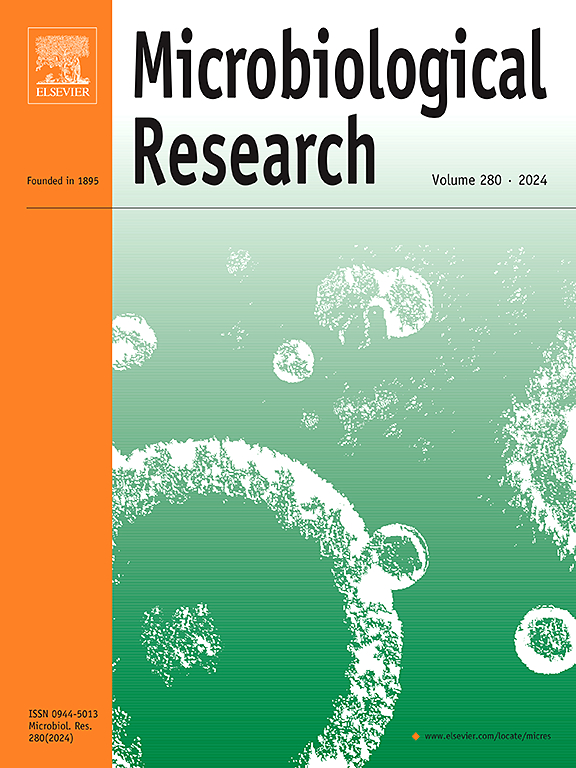假丝酵母(念珠菌)耳的氧化应激相关的过氧化物还氧化物蛋白Tsa1b有助于毒力和感染。
IF 6.9
1区 生物学
Q1 MICROBIOLOGY
引用次数: 0
摘要
准确识别耳念珠菌(原耳念珠菌)的困难和呈现的高耐药率增加了卫生保健机构的关注。因此,本研究的目的是分析真菌对氧化应激的反应。为了实现这一目标,我们分别使用qPCR和双向电泳检测了基因和蛋白的表达,发现过氧化氧还蛋白Tsa1b在氧化应激下上调。随后,通过对CRISPR-Cas9生成的C. auris Δtsa1b和C. auris Δtsa1b:: Tsa1b菌株进行表征,进一步研究Tsa1b的意义。结果表明,Δtsa1b菌株比野生型菌株更容易受到氧化和细胞壁应激源的影响,这与在氧化应激存在下生长时细胞壁β-葡聚糖含量增加一致。重要的是,Tsa1b也可以作为抗原在患者血清中检测到。此外,Δtsa1b菌株也更容易受到树突状细胞和骨髓源性巨噬细胞的存在。最后,在小鼠和mellonella Galleria中进行的体内感染显示,感染突变菌株的动物的疾病进展较慢。综上所述,过氧化物还氧蛋白Tsa1b已被确定为一个潜在的候选毒力因子,与金黄色葡萄球菌的氧化应激反应有关。这些发现促进了对金黄色葡萄球菌病理生物学的认识,并指出了Tsa1b在开发新的诊断和治疗方法方面的潜力。本文章由计算机程序翻译,如有差异,请以英文原文为准。
The oxidative stress-related peroxiredoxin Tsa1b of Candidozyma (Candida) auris contributes to virulence and infection
The difficulty of accurately identifying Candidozyma auris (formerly Candida auris) and the high resistance rates presented have increased the concern in the healthcare setting. Due to this, the aim of this study was to analyse the fungal response to oxidative stress. To achieve this goal, gene and protein expression were examined using qPCR and two-dimensional electrophoresis, respectively, peroxiredoxin Tsa1b being found to be upregulated under oxidative stress. Subsequently, the significance of Tsa1b was next investigated by characterizing the C. auris Δtsa1b and C. auris Δtsa1b::TSA1B strains generated by CRISPR-Cas9. The findings demonstrated that the Δtsa1b strain was more susceptible to oxidative and cell wall stressors than the wild-type strain, which was consistent with an increase in the cell wall β-glucan amounts when grown in the presence of oxidative stress. Importantly, Tsa1b has also been detected as an antigen by patient sera. Furthermore, the Δtsa1b strain was also more vulnerable to the presence of dendritic cells and bone marrow-derived macrophages. Finally, in vivo infections performed in Galleria mellonella and mice showed a slower progression of the disease in animals infected with the mutant strain. In conclusion, the peroxiredoxin Tsa1b has been identified as a potential candidate to be studied as a virulence factor implicated in the oxidative stress response of C. auris. These findings advance the knowledge of the pathobiology of C. auris and point out the potential of Tsa1b for the development of new diagnostic and therapeutic approaches.
求助全文
通过发布文献求助,成功后即可免费获取论文全文。
去求助
来源期刊

Microbiological research
生物-微生物学
CiteScore
10.90
自引率
6.00%
发文量
249
审稿时长
29 days
期刊介绍:
Microbiological Research is devoted to publishing reports on prokaryotic and eukaryotic microorganisms such as yeasts, fungi, bacteria, archaea, and protozoa. Research on interactions between pathogenic microorganisms and their environment or hosts are also covered.
 求助内容:
求助内容: 应助结果提醒方式:
应助结果提醒方式:


